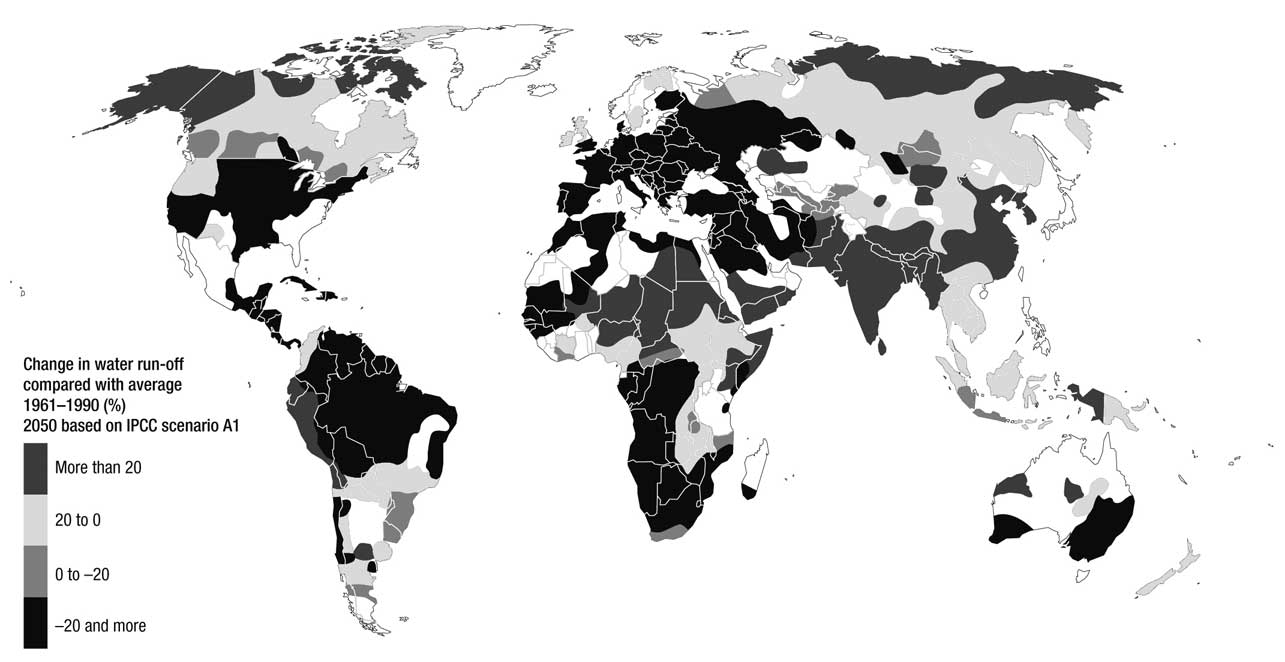
| Previous | Return to table of contents | Search Reports | Next |
| « Back to weltagrarbericht.de | ||
42 | IAASTD Global Report

Figure 1-19. Climate change and water run-off. Source: HDR, 2006.
|
Figure 1-19. Climate change and water run-off. Source: HDR, 2006. and to avoid the harmful use of pesticides. The successful, practical application of IPM is an example of the ecological services provided by agroecosystems, and the monetary, health and environmental benefits they provide. In the 1990s, management has become a key term in most debates on natural resources, agriculture included. The multifunctional character of agriculture implies a serious consideration of the links with the ecosystems in which agricultural systems are embedded, beyond measures and policies addressing specific resources such as water and soil. This is a very complex challenge concerning a multitude of actors. AKST and natural resource management (NRM) There is now a strategic understanding that "the management of natural resources clearly has social and behavioral components, the understanding of which is indispensable for orienting biophysical research to these resources. Behavioral and sociocultural variables of resource management are no less important for resource sustainability than physical parameters" (CGIAR, 2000). Practitioners of NRM research in agricultural development have adjusted their research agendas to address this problem, often under the headings "policies", "institutions", and "processes". This allows them to frame the debate on how access to resources should be regulated, and what types of institutional regimes are needed to ensure environmental sustainability of resource use in agriculture. Management of natural resources is articulated on at least two levels: the household and its livelihood, and the larger resource regimes on the community, the national and the international levels. For this aspect, AKST has benefited from research that |
deals with common property and common pool resources (Ostrom, 1990). A balanced research agenda focusing both on institutional aspects of resource management and on biophysical parameters of the systems is key for managing the multifunctional base and effects of agricultural production. AKST has also benefited from research on traditional agricultural systems and their knowledge base. While local knowledge forms are rarely equipped to respond to all the changes in contemporary agricultural systems, participatory research in AKST has demonstrated its value for grounded and adapted solutions. While national policies are evidently key in these areas, some approaches have become agreed notions in multilateral processes, like Agenda 21. Sustainable Land Management (SLM), for example, is defined as "the use of land resources, including soils, water, animals and plants, for the production of goods to meet changing human needs, while ensuring the long-term productive potential of these resources and the maintenance of their environmental functions" (UN, 1993a). This is a pertinent and comprehensive definition. However, its impact on the promotion of innovative management strategies and on national and international policies is scarcely visible to date. We may also note that efforts are devoted on the one hand to soil and water conservation, and on the other to conservation of biotic resources (agrobiodiversity), with little interlinkages between the two. In sum, a shift towards the integrated analysis of natural resource management has begun to transform the agricultural research agenda and AKST. However further progress in integrating biophysical with sociocultural and behavioral variables, and the recognition-in practice-of the multi- |
| Previous | Return to table of contents | Search Reports | Next |
| « Back to weltagrarbericht.de | ||